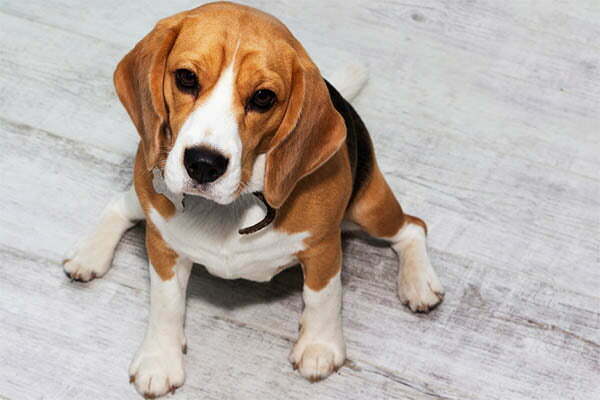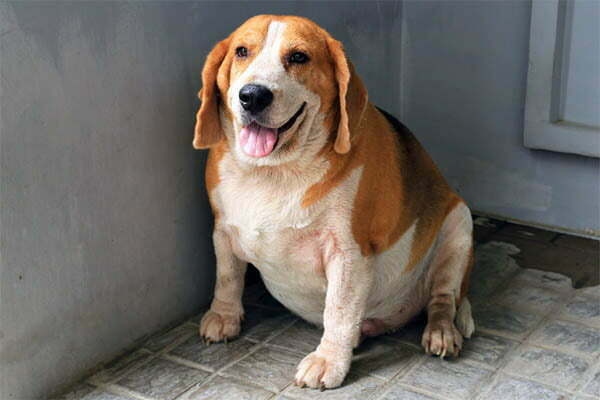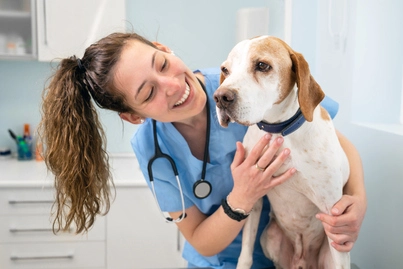Beagles are known to make excellent family companions. They have affectionate personalities but are also independent and are recognized by their compact size and sturdy build.

If beagles are not provided with adequate care, they are susceptible to weight gain just like many other breeds.
As a breed, beagles are known for their keen appetite and often seem to be constantly hungry and in search of food.
Unlike many other dogs, beagles tend to lack the ability to regulate their food intake and will often continue to eat to the point at which they gorge themselves.
If their diet is not monitored, there is a risk of beagles experiencing weight issues and possible health problems related to this.
If you are concerned by your beagles eating habits, you may have fears that they are potentially overweight.
There are several ways of checking whether this is the case. We have identified these in our guide below, along with the expected weight of a healthy beagle.
Their Appearance
One of the most dependable ways of telling whether a beagle is overweight is to assess its appearance. The ribs of a healthy beagle should not be visible because this can be a sign that they are too skinny. However, they should still be easy to feel.
Naturally, their ribs have a thin layer of fat protecting them, but this shouldn’t make them more challenging to feel.
You should also assess their spine, shoulders and hips. Similarly to their ribs, none should be visible because this can indicate that they are not carrying enough weight.
Though they are covered by a thin layer of fat, you should still be able to feel them without difficulty. A beagle of a healthy weight should also have a noticeable midsection/ waistline.
This region of their body should be more slender than their chest. Also, feel their tail. The base should be smooth to the touch with a thin layer of fat.
Lack of Shape and Definition
Beagles are known for their athletic build. Those that are overweight will lack definition and an athletic appearance.
Healthy beagles are rather muscular, so if yours is a little chunky and you are no longer able to pinpoint the exact position of their ribcage, then it is time to put them on a nutritional diet plan that will help them to lose some of this weight.
They Tire Easily
A beagle that is overweight is likely to tire very easily.
If you have noticed that they struggle to take more than a couple of steps before stopping and beginning to pant, this is a sign that they are overweight.
Of course, in warmer weather, panting and tiredness is expected behavior, but this shouldn’t be a regular occurrence.
If it does seem to be happening more frequently than you would expect, you should consult the vet, as they will be able to implement an exercise regime to help them.
Connect with a verified veterinarian in minutes. No waiting for appointments or office hours. No high fees. Your pet's health made convenient and worry-free.
They Can’t Groom Themselves
If you notice that your beagle is unable to scratch themselves, this is a telling sign that they are overweight. Although we often take it upon ourselves to groom our dogs, they will also do it independently daily.
However, a dog that is overweight will experience much more difficulty when attempting to scratch or bite themselves and this is often due to a loss of flexibility.
Ultimately, an overweight beagle will find it virtually impossible to groom themselves.
How much should a beagle weigh?
A healthy male beagle should weigh between 22 to 24 pounds whilst a healthy female beagle should weigh between 19.8 to 22 pounds.
Not only will the gender of your beagle impact their weight, but their height will also be influential. A beagle’s height is identified by the two following categories; those that are up to 13” tall and those that are up to 15” tall.
You should expect a tall beagle to weigh more. For example, a beagle of a healthy weight that grows up to 13” should weigh anything from 22 to 30 pounds.
However, a beagle that grows taller than this and reaches the 15” height range will likely weigh as little as 25 pounds and a maximum of 35 pounds.
Beagles that were the runt of the litter may not reach the same height and weight as their siblings, and their smallness is going to be reflected in their weight.
Although it may seem challenging to maintain the weight of your beagle, it is of paramount importance.
As mentioned, beagles will continue to eat even when they have surpassed the feeling of fullness, so they depend on you to ensure that they are exercised and fed the correct amount of food.
What should a 3-month-old beagle weigh?
A healthy 3-month-old beagle puppy should weigh between 9.5 and 10.4 pounds. As they double in age and reach the 6-month mark, their weight should also be almost double this too.
Those with a more diminutive stature are likely to weigh around 17.2 pounds. However, those that have a slightly larger build should weigh around 18.7 pounds.
Are beagles more likely to gain weight?
The majority of breeds are pretty good at self-regulating how much food they consume.
Typically, they will stop eating once they have developed a feeling of fullness or once they have eaten enough food to provide them with enough energy for the day’s activities.
Beagles on the other hand, do not share this capability and are often known to overeat. Recognized as opportunists, they will often try to eat anything that they can get their paws on, and as a result, there is an increased risk of them overindulging.
A beagle that is rather inactive is more likely to gain weight too.
For example, beagles that are of a senior age don’t tend to run and play as much as they once did, and those with stubborn personalities may also be more reluctant to engage in physical activity, which places them in a more vulnerable position when it comes to weight gain.
As their owner, you are responsible for regulating your beagle’s daily food intake.
Because of this, you should ensure that they aren’t overfed but are instead fed 2 to 3 times a day.
Also, although their begging may be difficult to resist, you should be careful with the portion sizes, ensuring that you give them healthy food at each meal time.
Are overweight beagles unhealthy?

An overweight beagle has a greater risk of developing health issues during the later stages of their life, some of which can be rather severe.
Sometimes, a beagle may develop arthritis, diabetes, or heart problems. They are also more susceptible to breathing problems as the added weight puts more pressure on their bodies. Furthermore, weight gain can also shorten your dog’s lifespan.
In some cases, an illness of some kind may be responsible for your dog’s weight gain.
A common symptom of cushing’s disease in dogs is weight gain. Due to an increase in cortisol production, they are more likely to bloat too, which can result in your dog appearing larger than normal.
Dogs suffering from Addison’s disease typically experience the opposite symptoms. Vomiting combined with a loss of appetite can cause them to lose weight rather than put it on.
If your dog’s weight seems different from usual and their eating habits have also changed too, it may be worth consulting the vet to identify whether a disease of some kind is responsible for this sudden change.
How can you help your beagle lose weight?
Helping your beagle lose weight requires a lot of effort on your behalf. Although it may seem like a difficult, time-consuming task, it is a crucial part of returning your dog to a healthier and fitter state.
Not only will you feel much happier as their owner, but they will also feel this happiness.
Before implementing any weight loss techniques you should speak to a vet. They will be able to inform you of the best practices that are suitable for your dog.
Aside from this, they can tell you the exact weight your dog should be at and assess your beagle to ensure that they aren’t suffering from any underlying health problems causing them to gain weight excessively.
Reduce the amount of treats that you feed them
Treats are a great way of rewarding your dog for good behaviour. Often you give them one and before you know it, you are almost halfway through the packet.
Although it is easy to overlook the number of treats that you give your dog, as many assume that they do not have a harmful impact because they aren’t a substantial meal, they can actually cause weight gain.
To begin, you should avoid cutting them out completely, but instead reduce the amount that you would typically feed them.
Remember to account for the treats they are given in their daily calorie intake. Ideally, you should transition to treats that have a low fat and calorie content as they provide a healthier alternative for your dog.
Although you don’t necessarily need to cut treats out of their diet completely, it is important to ensure that you are sensible with the quantity and size of the treats that you feed to them.
If you are still giving your dog a substantially sized treat less frequently throughout the day, they are still at risk of becoming overweight.
Implement a nutritional plan
Your dog needs access to the correct nutrients to provide them with energy and keep them healthy. If you are not confident in putting together a nutrition/diet plan that is suitable for your dog, a vet will be able to.
Once you know the weight your dog needs to lose, you will then need to feed them according to this plan and remember to adopt a routine rather than feeding your dog when they appear hungry.
Feed them the correct portions
It is likely that many dog owners are guilty of putting food into their pet’s bowl and putting it on the floor for them to eat without paying much attention to the measurements.
Feeding them the correct portions for their age and size will ensure that they are not overfed but are getting the exact amount of food they need.
Reductions in portions should be done gradually rather than all at once. You must also ensure they are still getting the calories needed to lose weight.
Begin by reducing their meal size by a small amount, until noticeable signs of weight loss. If your dog continues to lose weight, you can then continue to cut down their portions until they are eating the right amount for their weight.
Establish an exercise regime
When helping your beagle to lose weight, you should dive in and start taking them on lengthy and intense walks. You should instead begin slowly and exercise them to their capabilities as this ensures that there isn’t too much pressure on their bodies.
Eventually, as they begin to lose weight you can increase the longevity and intensity of their walks.
Final Thoughts
As you can see, there are many ways of identifying an overweight beagle. The most apparent signs can be seen through their visual appearance.
While beagles are more susceptible to weight gain in comparison to many other dog breeds, they are ways of resolving this issue so that it doesn’t become overly problematic and affect their health.
You must ensure that they are fed correctly and exercised properly so that they maintain a healthy weight for their age and size.
If your beagle is overweight, there are many steps that you can follow to rectify this issue, and, likely, you will soon see them return to the right weight.

